Russian vs Chilean Community Comparison
COMPARE
Russian
Chilean
Social Comparison
Social Comparison
Russians
Chileans
8,595
SOCIAL INDEX
83.4/ 100
SOCIAL RATING
62nd/ 347
SOCIAL RANK
8,759
SOCIAL INDEX
85.1/ 100
SOCIAL RATING
51st/ 347
SOCIAL RANK
Chilean Integration in Russian Communities
The statistical analysis conducted on geographies consisting of 251,253,773 people shows a weak positive correlation between the proportion of Chileans within Russian communities in the United States with a correlation coefficient (R) of 0.233. On average, for every 1% (one percent) increase in Russians within a typical geography, there is an increase of 0.012% in Chileans. To illustrate, in a geography comprising of 100,000 individuals, a rise of 1,000 Russians corresponds to an increase of 12.1 Chileans.
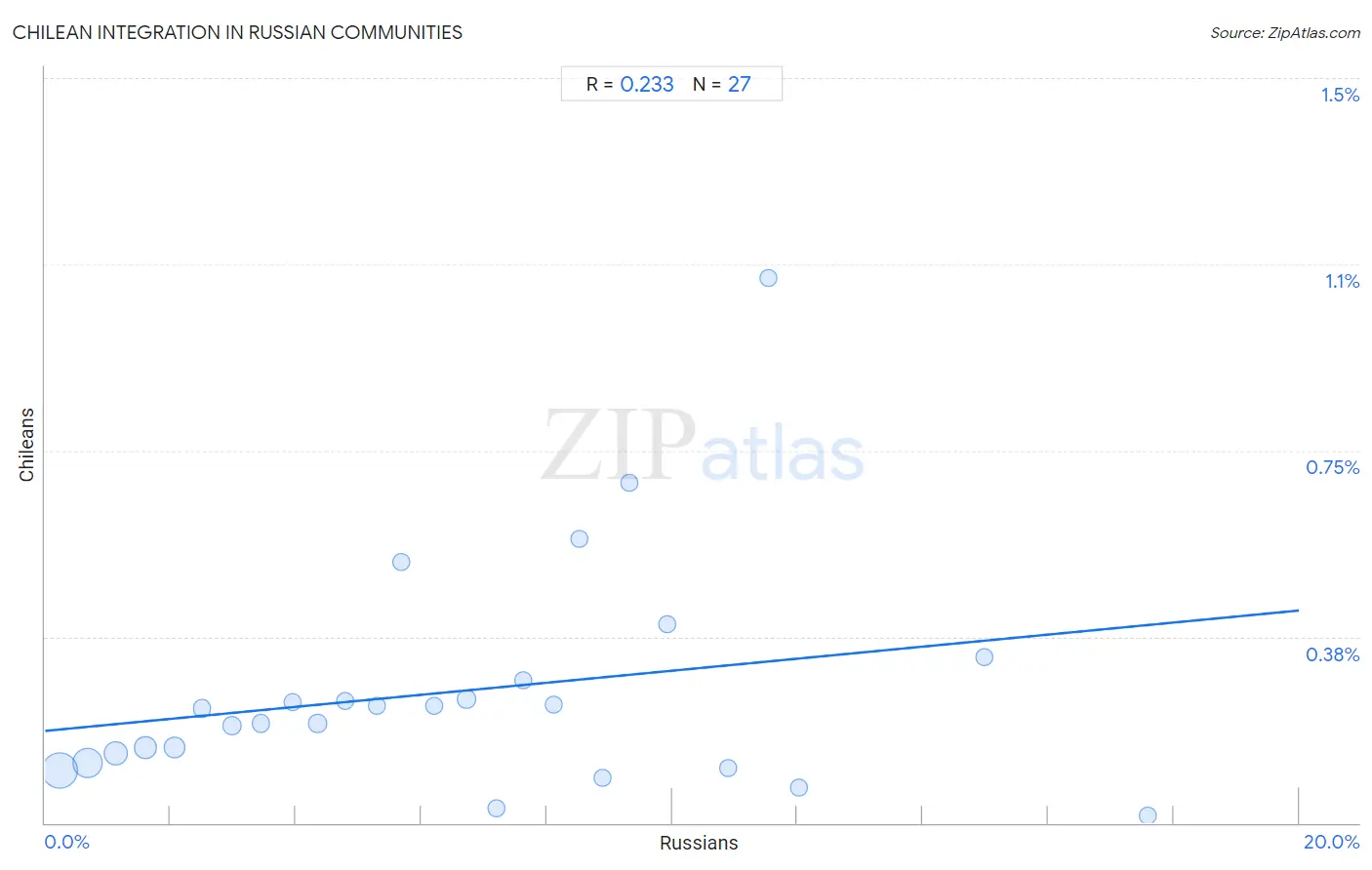
Russian vs Chilean Income
When considering income, the most significant differences between Russian and Chilean communities in the United States are seen in per capita income ($53,154 compared to $46,459, a difference of 14.4%), median male earnings ($63,939 compared to $56,973, a difference of 12.2%), and median family income ($120,487 compared to $108,429, a difference of 11.1%). Conversely, both communities are more comparable in terms of householder income under 25 years ($54,389 compared to $53,185, a difference of 2.3%), householder income over 65 years ($67,626 compared to $63,957, a difference of 5.7%), and wage/income gap (28.0% compared to 26.3%, a difference of 6.5%).

| Income Metric | Russian | Chilean |
| Per Capita Income | Exceptional $53,154 | Exceptional $46,459 |
| Median Family Income | Exceptional $120,487 | Exceptional $108,429 |
| Median Household Income | Exceptional $98,008 | Exceptional $90,605 |
| Median Earnings | Exceptional $53,334 | Exceptional $48,504 |
| Median Male Earnings | Exceptional $63,939 | Exceptional $56,973 |
| Median Female Earnings | Exceptional $44,169 | Exceptional $40,757 |
| Householder Age | Under 25 years | Exceptional $54,389 | Exceptional $53,185 |
| Householder Age | 25 - 44 years | Exceptional $110,398 | Exceptional $99,900 |
| Householder Age | 45 - 64 years | Exceptional $116,328 | Exceptional $106,611 |
| Householder Age | Over 65 years | Exceptional $67,626 | Exceptional $63,957 |
| Wage/Income Gap | Tragic 28.0% | Fair 26.3% |
Russian vs Chilean Poverty
When considering poverty, the most significant differences between Russian and Chilean communities in the United States are seen in married-couple family poverty (4.3% compared to 4.9%, a difference of 14.4%), receiving food stamps (9.6% compared to 11.0%, a difference of 14.0%), and family poverty (7.5% compared to 8.5%, a difference of 13.5%). Conversely, both communities are more comparable in terms of single mother poverty (27.3% compared to 27.9%, a difference of 2.1%), female poverty among 18-24 year olds (19.5% compared to 19.1%, a difference of 2.1%), and single female poverty (19.2% compared to 19.9%, a difference of 3.6%).
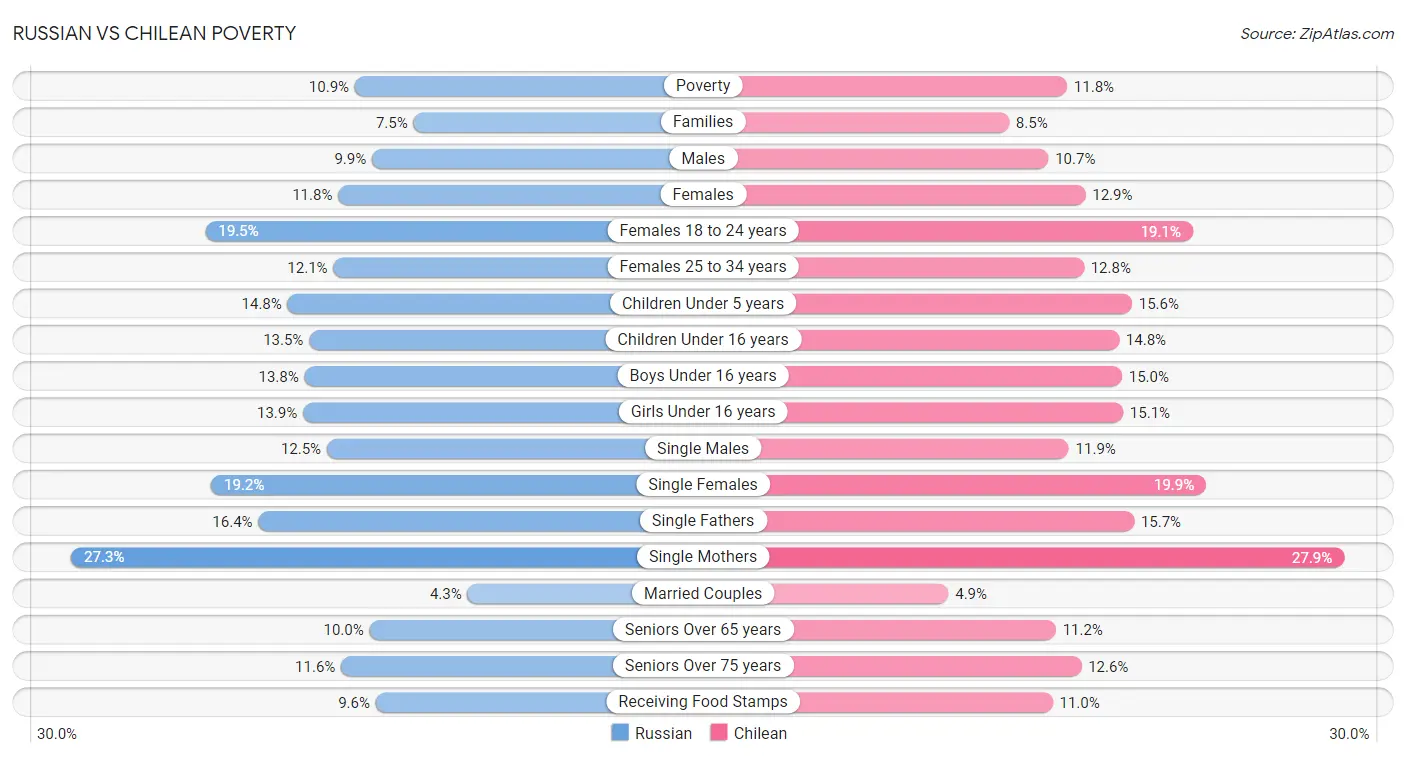
| Poverty Metric | Russian | Chilean |
| Poverty | Exceptional 10.9% | Excellent 11.8% |
| Families | Exceptional 7.5% | Excellent 8.5% |
| Males | Exceptional 9.9% | Excellent 10.7% |
| Females | Exceptional 11.8% | Excellent 12.9% |
| Females 18 to 24 years | Exceptional 19.5% | Exceptional 19.1% |
| Females 25 to 34 years | Exceptional 12.1% | Exceptional 12.8% |
| Children Under 5 years | Exceptional 14.8% | Exceptional 15.6% |
| Children Under 16 years | Exceptional 13.5% | Exceptional 14.8% |
| Boys Under 16 years | Exceptional 13.8% | Exceptional 15.0% |
| Girls Under 16 years | Exceptional 13.9% | Exceptional 15.1% |
| Single Males | Excellent 12.5% | Exceptional 11.9% |
| Single Females | Exceptional 19.2% | Exceptional 19.9% |
| Single Fathers | Fair 16.4% | Exceptional 15.7% |
| Single Mothers | Exceptional 27.3% | Exceptional 27.9% |
| Married Couples | Exceptional 4.3% | Excellent 4.9% |
| Seniors Over 65 years | Exceptional 10.0% | Fair 11.2% |
| Seniors Over 75 years | Excellent 11.6% | Poor 12.6% |
| Receiving Food Stamps | Exceptional 9.6% | Excellent 11.0% |
Russian vs Chilean Unemployment
When considering unemployment, the most significant differences between Russian and Chilean communities in the United States are seen in unemployment among seniors over 75 years (8.9% compared to 8.4%, a difference of 5.4%), unemployment among women with children under 18 years (5.1% compared to 5.3%, a difference of 4.9%), and unemployment among ages 20 to 24 years (10.4% compared to 10.0%, a difference of 4.5%). Conversely, both communities are more comparable in terms of unemployment among women with children under 6 years (7.2% compared to 7.2%, a difference of 0.11%), unemployment among ages 16 to 19 years (17.6% compared to 17.6%, a difference of 0.27%), and unemployment among women with children ages 6 to 17 years (8.8% compared to 8.8%, a difference of 0.41%).
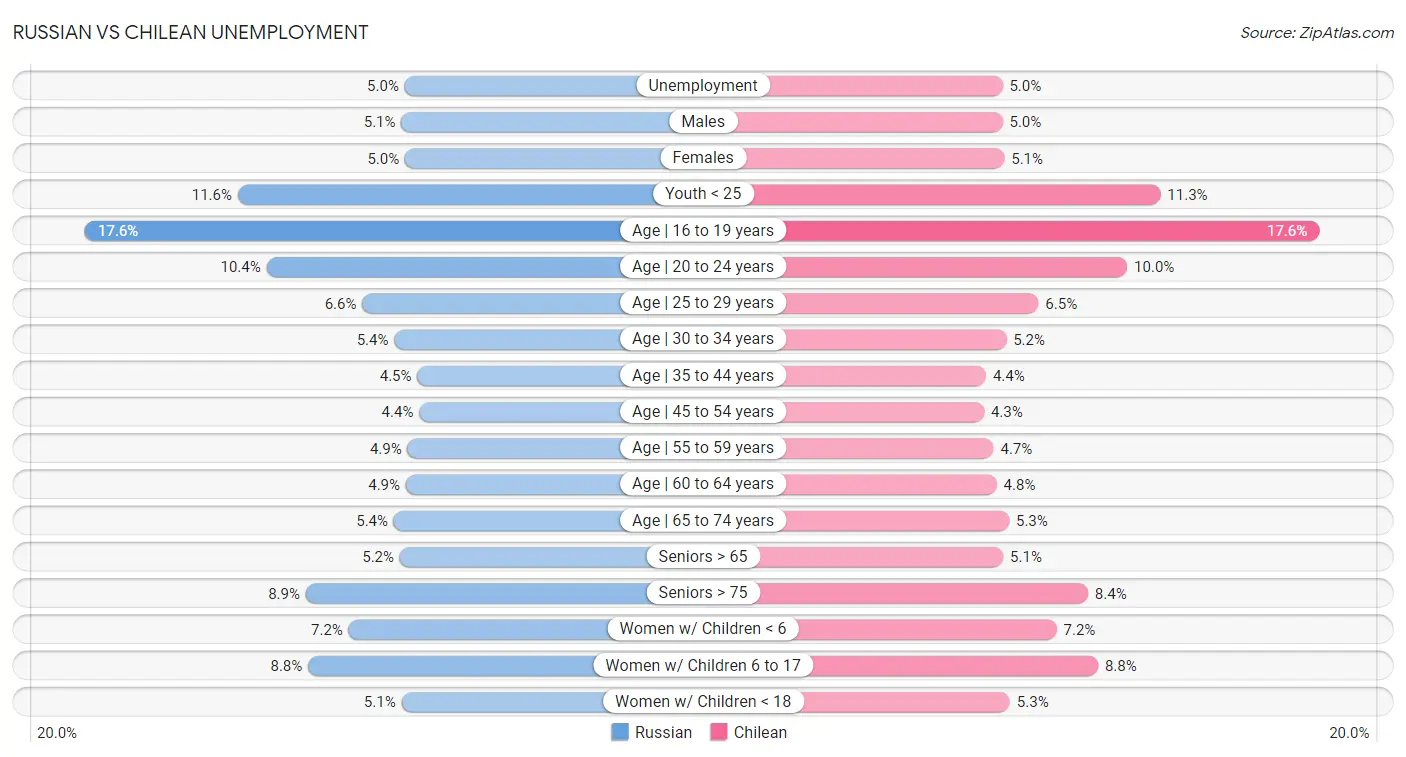
| Unemployment Metric | Russian | Chilean |
| Unemployment | Exceptional 5.0% | Exceptional 5.0% |
| Males | Exceptional 5.1% | Exceptional 5.0% |
| Females | Exceptional 5.0% | Excellent 5.1% |
| Youth < 25 | Average 11.6% | Exceptional 11.3% |
| Age | 16 to 19 years | Average 17.6% | Average 17.6% |
| Age | 20 to 24 years | Fair 10.4% | Exceptional 10.0% |
| Age | 25 to 29 years | Average 6.6% | Excellent 6.5% |
| Age | 30 to 34 years | Good 5.4% | Exceptional 5.2% |
| Age | 35 to 44 years | Exceptional 4.5% | Exceptional 4.4% |
| Age | 45 to 54 years | Exceptional 4.4% | Exceptional 4.3% |
| Age | 55 to 59 years | Fair 4.9% | Exceptional 4.7% |
| Age | 60 to 64 years | Poor 4.9% | Good 4.8% |
| Age | 65 to 74 years | Fair 5.4% | Good 5.3% |
| Seniors > 65 | Average 5.2% | Excellent 5.1% |
| Seniors > 75 | Fair 8.9% | Exceptional 8.4% |
| Women w/ Children < 6 | Exceptional 7.2% | Exceptional 7.2% |
| Women w/ Children 6 to 17 | Excellent 8.8% | Excellent 8.8% |
| Women w/ Children < 18 | Exceptional 5.1% | Good 5.3% |
Russian vs Chilean Labor Participation
When considering labor participation, the most significant differences between Russian and Chilean communities in the United States are seen in in labor force | age 16-19 (36.7% compared to 35.8%, a difference of 2.7%), in labor force | age > 16 (64.9% compared to 66.0%, a difference of 1.8%), and in labor force | age 30-34 (85.5% compared to 84.9%, a difference of 0.65%). Conversely, both communities are more comparable in terms of in labor force | age 45-54 (83.4% compared to 83.4%, a difference of 0.070%), in labor force | age 20-64 (80.0% compared to 80.1%, a difference of 0.080%), and in labor force | age 35-44 (85.0% compared to 84.7%, a difference of 0.31%).

| Labor Participation Metric | Russian | Chilean |
| In Labor Force | Age > 16 | Poor 64.9% | Exceptional 66.0% |
| In Labor Force | Age 20-64 | Exceptional 80.0% | Exceptional 80.1% |
| In Labor Force | Age 16-19 | Average 36.7% | Poor 35.8% |
| In Labor Force | Age 20-24 | Fair 74.8% | Poor 74.5% |
| In Labor Force | Age 25-29 | Exceptional 85.3% | Excellent 85.0% |
| In Labor Force | Age 30-34 | Exceptional 85.5% | Excellent 84.9% |
| In Labor Force | Age 35-44 | Exceptional 85.0% | Exceptional 84.7% |
| In Labor Force | Age 45-54 | Exceptional 83.4% | Exceptional 83.4% |
Russian vs Chilean Family Structure
When considering family structure, the most significant differences between Russian and Chilean communities in the United States are seen in single mother households (5.3% compared to 6.1%, a difference of 16.0%), single father households (2.0% compared to 2.2%, a difference of 10.5%), and births to unmarried women (28.0% compared to 30.7%, a difference of 9.5%). Conversely, both communities are more comparable in terms of married-couple households (48.2% compared to 47.5%, a difference of 1.4%), family households (63.4% compared to 65.2%, a difference of 2.8%), and currently married (48.6% compared to 47.0%, a difference of 3.3%).

| Family Structure Metric | Russian | Chilean |
| Family Households | Tragic 63.4% | Exceptional 65.2% |
| Family Households with Children | Tragic 26.5% | Exceptional 28.1% |
| Married-couple Households | Exceptional 48.2% | Exceptional 47.5% |
| Average Family Size | Tragic 3.12 | Average 3.23 |
| Single Father Households | Exceptional 2.0% | Exceptional 2.2% |
| Single Mother Households | Exceptional 5.3% | Good 6.1% |
| Currently Married | Exceptional 48.6% | Good 47.0% |
| Divorced or Separated | Exceptional 11.5% | Good 12.0% |
| Births to Unmarried Women | Exceptional 28.0% | Good 30.7% |
Russian vs Chilean Vehicle Availability
When considering vehicle availability, the most significant differences between Russian and Chilean communities in the United States are seen in no vehicles in household (11.6% compared to 9.9%, a difference of 17.3%), 4 or more vehicles in household (6.0% compared to 6.4%, a difference of 7.0%), and 3 or more vehicles in household (18.8% compared to 19.7%, a difference of 4.6%). Conversely, both communities are more comparable in terms of 1 or more vehicles in household (88.7% compared to 90.2%, a difference of 1.7%), 2 or more vehicles in household (54.8% compared to 56.1%, a difference of 2.4%), and 3 or more vehicles in household (18.8% compared to 19.7%, a difference of 4.6%).

| Vehicle Availability Metric | Russian | Chilean |
| No Vehicles Available | Tragic 11.6% | Excellent 9.9% |
| 1+ Vehicles Available | Tragic 88.7% | Good 90.2% |
| 2+ Vehicles Available | Fair 54.8% | Excellent 56.1% |
| 3+ Vehicles Available | Poor 18.8% | Good 19.7% |
| 4+ Vehicles Available | Poor 6.0% | Good 6.4% |
Russian vs Chilean Education Level
When considering education level, the most significant differences between Russian and Chilean communities in the United States are seen in no schooling completed (1.7% compared to 2.0%, a difference of 22.3%), professional degree (6.3% compared to 5.3%, a difference of 20.4%), and doctorate degree (2.6% compared to 2.2%, a difference of 18.6%). Conversely, both communities are more comparable in terms of nursery school (98.4% compared to 98.0%, a difference of 0.40%), kindergarten (98.4% compared to 98.0%, a difference of 0.41%), and 1st grade (98.3% compared to 97.9%, a difference of 0.41%).
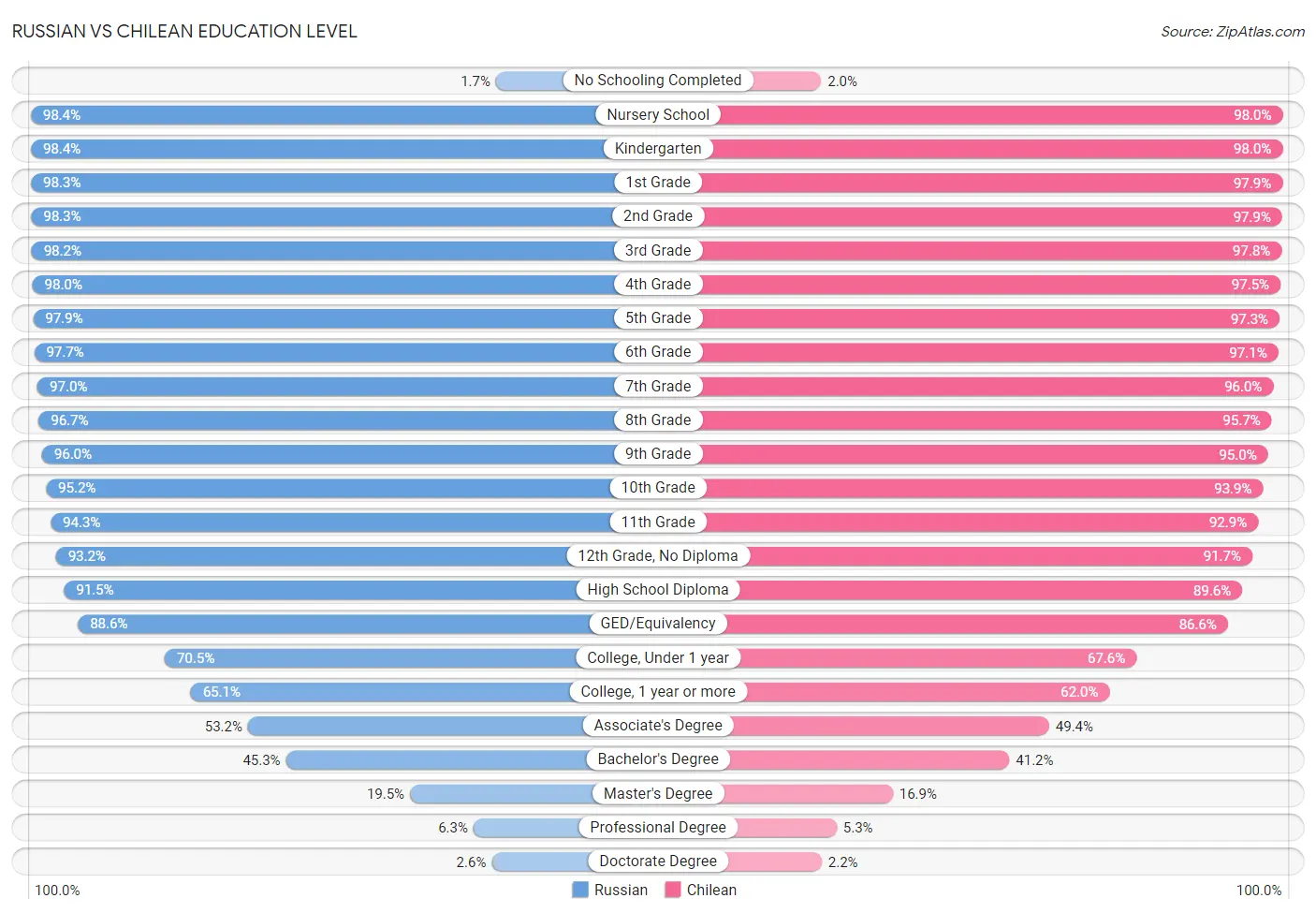
| Education Level Metric | Russian | Chilean |
| No Schooling Completed | Exceptional 1.7% | Good 2.0% |
| Nursery School | Exceptional 98.4% | Average 98.0% |
| Kindergarten | Exceptional 98.4% | Average 98.0% |
| 1st Grade | Exceptional 98.3% | Average 97.9% |
| 2nd Grade | Exceptional 98.3% | Average 97.9% |
| 3rd Grade | Exceptional 98.2% | Average 97.8% |
| 4th Grade | Exceptional 98.0% | Average 97.5% |
| 5th Grade | Exceptional 97.9% | Average 97.3% |
| 6th Grade | Exceptional 97.7% | Average 97.1% |
| 7th Grade | Exceptional 97.0% | Average 96.0% |
| 8th Grade | Exceptional 96.7% | Average 95.7% |
| 9th Grade | Exceptional 96.0% | Good 95.0% |
| 10th Grade | Exceptional 95.2% | Good 93.9% |
| 11th Grade | Exceptional 94.3% | Excellent 92.9% |
| 12th Grade, No Diploma | Exceptional 93.2% | Excellent 91.7% |
| High School Diploma | Exceptional 91.5% | Good 89.6% |
| GED/Equivalency | Exceptional 88.6% | Excellent 86.6% |
| College, Under 1 year | Exceptional 70.5% | Exceptional 67.6% |
| College, 1 year or more | Exceptional 65.1% | Exceptional 62.0% |
| Associate's Degree | Exceptional 53.2% | Exceptional 49.4% |
| Bachelor's Degree | Exceptional 45.3% | Exceptional 41.2% |
| Master's Degree | Exceptional 19.5% | Exceptional 16.9% |
| Professional Degree | Exceptional 6.3% | Exceptional 5.3% |
| Doctorate Degree | Exceptional 2.6% | Exceptional 2.2% |
Russian vs Chilean Disability
When considering disability, the most significant differences between Russian and Chilean communities in the United States are seen in hearing disability (3.2% compared to 2.9%, a difference of 10.7%), disability age under 5 (1.4% compared to 1.3%, a difference of 6.8%), and disability age 65 to 74 (21.2% compared to 22.0%, a difference of 4.2%). Conversely, both communities are more comparable in terms of disability age 35 to 64 (10.2% compared to 10.2%, a difference of 0.60%), disability age 5 to 17 (5.3% compared to 5.4%, a difference of 1.1%), and disability age over 75 (45.5% compared to 46.5%, a difference of 2.1%).
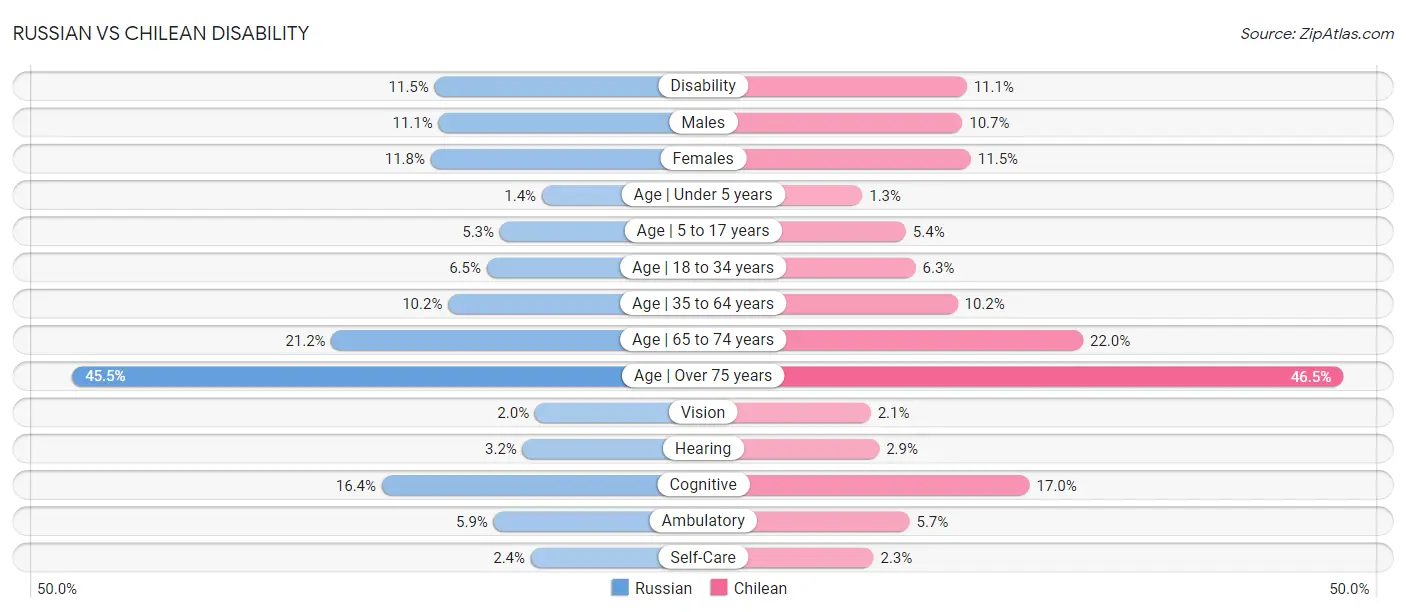
| Disability Metric | Russian | Chilean |
| Disability | Excellent 11.5% | Exceptional 11.1% |
| Males | Good 11.1% | Exceptional 10.7% |
| Females | Exceptional 11.8% | Exceptional 11.5% |
| Age | Under 5 years | Tragic 1.4% | Poor 1.3% |
| Age | 5 to 17 years | Exceptional 5.3% | Exceptional 5.4% |
| Age | 18 to 34 years | Good 6.5% | Exceptional 6.3% |
| Age | 35 to 64 years | Exceptional 10.2% | Exceptional 10.2% |
| Age | 65 to 74 years | Exceptional 21.2% | Exceptional 22.0% |
| Age | Over 75 years | Exceptional 45.5% | Exceptional 46.5% |
| Vision | Exceptional 2.0% | Exceptional 2.1% |
| Hearing | Tragic 3.2% | Excellent 2.9% |
| Cognitive | Exceptional 16.4% | Excellent 17.0% |
| Ambulatory | Exceptional 5.9% | Exceptional 5.7% |
| Self-Care | Excellent 2.4% | Exceptional 2.3% |